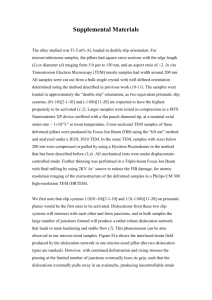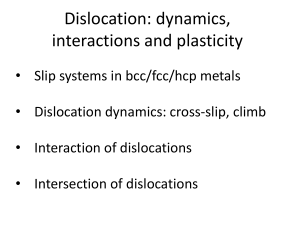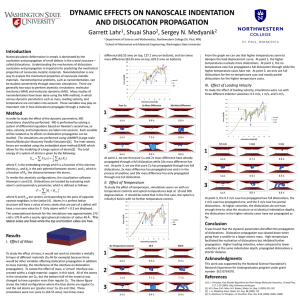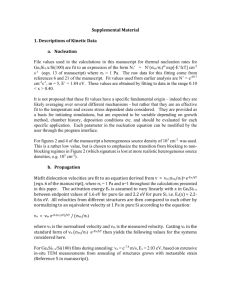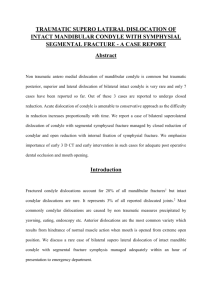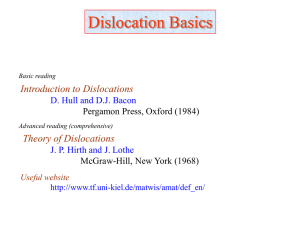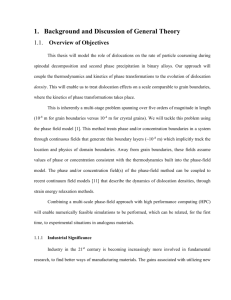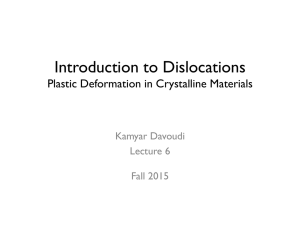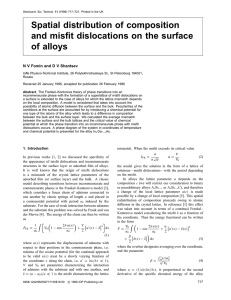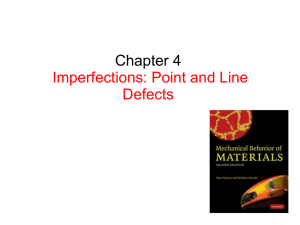FK_Models
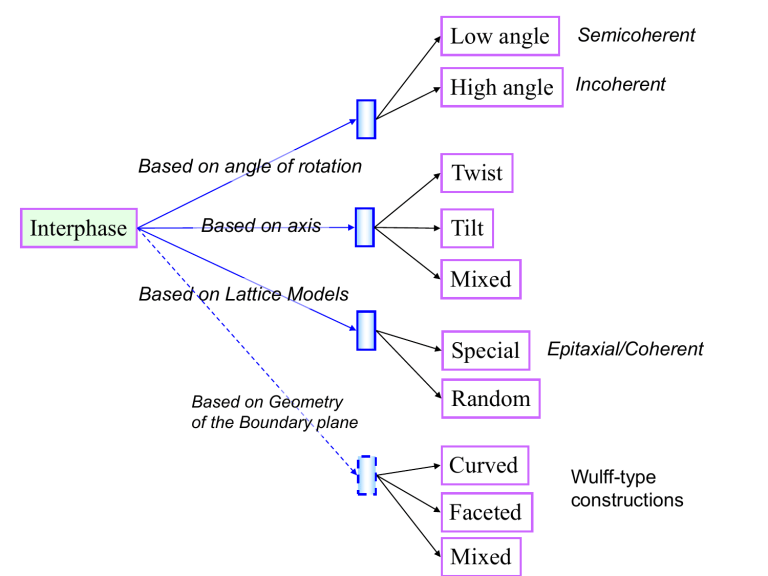
Interphase
Based on angle of rotation
Based on axis
Based on Lattice Models
Based on Geometry of the Boundary plane
Low angle Semicoherent
High angle Incoherent
Twist
Tilt
Mixed
Special Epitaxial/Coherent
Random
Curved
Faceted
Mixed
Wulff-type constructions
Interfaces
• Frankel-Kontorova (Frank-Van der Merwe) model
– Localization of distortions (dislocations) in commensurate case
– Localization & Aubry Transition for incommensurate case
• Vernier
– Rotated Registries
– Co-incidence of Reciprocal Lattice Approach
(Fletcher-Lodge; Near Coincident Site Model)
See additional reading in Dislocations/Grain Boundary directories for original papers
Interfaces
Elastic distortions
Interface Bonding
Elastic Distortions
E =
S
[W(x i
-x i-1
) + V(x i
) ]
V(x) = Interface Bonding
W(x) = Elastic Energy
Y. Frenkel & T. Kontorova, Z. Exp. Th. Phys. 8, 89 (1938), ibid. p1340, p1349
F. Frank & J. H. van der Merwe, Proc. R. Soc. London Ser. A 198, 205 (1949) J.
P. Hirth & J. Lothe, Theory of Dislocations, Krieger Publishing Company, Malabar, 1982 .
Frankel Kontorova Model
L
1
1
W = (1/2)
S
(x l+1
-x l
– L) 2 -- Springs
V = K
S
(1-cos 2 p x l
) -- Substrate
Iff L=1, pseudomorphic
The strength of the coupling to the substrate is given by K. When weak, e.g. large distances,
K
0, spacing of L. When strong, K
inf the spacing will be 1
Frank Van der Merwe
Displacement z as a function of “n” of x n continuous).
(extended to
Solutions in terms of sinc functions, called solitons (which are dislocations by another name)
FK Solutions
• These are very rich
• They depend upon both K and L
• Two main cases
– L = N/M (integers), commensurate
– The others (incommensurate)
2.5
2
1.5
1
0.5
0
-0.5
0
L=4/5
1 2 3 4 5 6
2
1.5
1
0.5
0
0
-0.5
L=6/7
1 2 3 4 5 6
2.5
2
1.5
1
0.5
0
-0.5
0
L=8/9
1 2 3 4 5 6 7 8
2.5
2
1.5
1
0.5
0
-0.5
0
K=0
1 2 3 4 5
W = (1/2)
S
(x l+1
-x l
– L) 2 -- Springs
V = K
S
(1-cos 2 p x l
) -- Substrate
6
2.5
2
1.5
1
0.5
0
-0.5
0 1
K=1/50
2 3 4 5
W = (1/2)
S
(x l+1
-x l
– L) 2 -- Springs
V = K
S
(1-cos 2 p x l
) -- Substrate
6
2.5
2
1.5
1
0.5
0
-0.5
0 1
K=1/20
2 3 4 5
W = (1/2)
S
(x l+1
-x l
– L) 2 -- Springs
V = K
S
(1-cos 2 p x l
) -- Substrate
6
2.5
2
1.5
1
0.5
0
-0.5
0 1
K=1/10
2 3 4 5
W = (1/2)
S
(x l+1
-x l
– L) 2 -- Springs
V = K
S
(1-cos 2 p x l
) -- Substrate
6
2.5
2
1.5
1
0.5
0
-0.5
0 1
K=1/5
2 3 4 5
W = (1/2)
S
(x l+1
-x l
– L) 2 -- Springs
V = K
S
(1-cos 2 p x l
) -- Substrate
6
2
Incommensurate Case
1.5
L=6/7
1
0.5
0
0
-0.5
1 2 3 4 5
Reduce to equivalent positions within 0 1
2.5
6
2
2
1.5
1
0.5
0
0
-0.5
L=6/7
1
1.5
1
0.5
0
0
-0.5
L=8/9
1
In the limit as the repeat period
Infinity, all points on curve exist in initial case
Aubry Transition
• If K is small (weak coupling), all points occupied
– Displacing interface does not change which points are occupied
– Zero static friction (ignoring phonon coupling)
• If K is large enough, strain localized
– Incommensurate set of misfit dislocations (i.e. not periodic)
Aubry Transition with K
Unpinned
Zero friction
(T=0)
Pinned
K large
S. Aubry & P. Y. Ledaeron, Physica D 8, 381 (1983)
T van Erp,
PhD thesis,
1999
Sliding is dislocation motion
Misfit Dislocations
F
Bv
CSL Boundary Model
A. Merkle & L. D. Marks, Tribology Letts, 26 , 73 (2007)
A. Merkle & L. D. Marks, Phil Mag Letts, 87 , 527 (2007)
+
∑1
Friction vs. Misorientation
∑25 ∑13 ∑17 ∑5
Low energy, low dislocation density, high friction
S boundaries.
High friction
S orientations not
(yet) demonstrated
(Really only
Franks’ formula)
Sliding on Graphite: Comparison of
Theory & Experiment
S
19?
Experiment Theoretical Fit
Dominant term is dislocation density
A. Merkle & L.D. Marks, Phil Mag Letts, 87 , 527 (2007)
Change in friction above transition
F. Lancon, Europhys. Lett 57, 74, 2002
Frank Van der Merwe
Displacement z as a function of “n” of x n continuous).
(extended to
Solutions in terms of sinc functions, called solitons (which are dislocations by another name)
Frank-Van der Merwe
Dislocation
Displacement as a function of position
Frank-Van der Merwe
Examples of Solitons (STM)
Au (111) Cu on Ru
Juan de la Figuera, Karsten Pohl, Andreas K. Schmid, Norm C. Bartelt and Robert Q. Hwang
Role of the Vernier
L can be large (or small), and in 2D problem is richer
2, 45
0
rotation
2, 45
0
rotation
Hexagonal on Square
Hexagonal on Square
Exact match
Near match (would be strained)
Hexagonal on Square
Exact match
Strained to match
Near Coincidence
• The two materials may not exactly superimpose
– No exact CSL
– No exact epitaxy
• Alternative (equivalent) model
– Expand potential in more general form
– Expand elastic strain field
– See paper by Fletcher & Lodge
Sketch of Model 1
Sketch of Model 2
Sketch of Model 3
Interface orientation
• To first order in reciprocal space:
E
k
A
{ U ( q
A
)
o k
A
( q
A
)}
2
k
B
{ U ( q
B
)
o k
B
( q
B
)}
2
–
U ( q )
exp( 2 p iq .
r i
) Unitary structure factor
– v o
(q) – Interatomic potential term
– k – Distance between diffraction spots (wavevector of elastic distortion) – dominates if small
Bring two surfaces into contact
W( r )
Crystal
V( r )
• Crystal has a periodic potential
– V( r ) =
S v( g )exp(i g .
r )
– Periodic displacements in quasicrystal
Quasicrystal
• Quasicrystal has an quasiperiodic potential
– W( r ) =
S w( q )exp(i q .
r )
– Quasiperiodic displacements in crystal (Following Fletcher & Lodge)
Interfacial energy calculation
E
k
A
{ U ( q
A
Ignored Ignored
) k
o
A
( q
A
)}
2
k
B
{ U ( q
B
)
o k
B
( q
B
)}
2
U ( q
A
) ~ I ( q
A
) (measured for QC) l
=12 o
D
=6 o
Calculated energies for two k
Total energy
Experiments + Theory
Minority
Majority
Widjaja & Marks, Phil Mag Letts, 2003. 83 (1) 47.
Widjaja & Marks, PRB, 2003. 68 (13) 134211.
Summary
• FK (FVdM) models are solvable approximations
– Strain localization/solitons/misfit dislocations
– Commensuration matters
• Commensurate: periodic array of misfit dislocations
• Incommensurate, either aperiodic array of misfit or no matching
– In 2D problem can be more complicated
• Rotated alignments
– Near Coincident orientations
• Energy scales ~1/k, alignment in reciprocal space
Brownian Motion of Defects
S.L. Dudarev, J.-L. Boutard, R. L ässer, M.J. Caturla, P.M. Derlet, M. Fivel,
C.-C. Fu, M.Y. Lavrentiev, L. Malerba, M. Mrovec, D. Nguyen-Manh,
K. Nordlund, M. Perlado, R. Schäublin, H. Van Swygenhoven,
D. Terentyev, J. Wallenius, D. Weygand and F. Willaime
EURATOM Associations
Brownian Motion
Vacancy Motion Interstitial Motion
The dynamics of microstructural evolution
50 nm
Thermal Brownian motion of nanoscale prismatic dislocation loops in pure iron at 610K (courtesy of K. Arakawa, Osaka
University, Japan).
Science 318 (2007) 956
Growth of dislocation loops in ultra-pure iron under in-situ self-ion irradiation at 300K
(courtesy of Z. Yao and M. L. Jenkins,
Oxford University, UK).
Philos. Magazine (2007) in the press
The fundamental microscopic objects
P. Olsson, 2002
Density functional theory calculations showed that magnetism was responsible for one of the most significant feature of the FeCr phase diagram (2002). DFT calculations also identified the pathways of migration of defects in iron (2004), as illustrated by the movie above.
Migration of radiation defects in pure metals
Fe: migration of a single 110 selfinterstitial defect at 200 °C.
W: migration of a single 111 selfinterstitial defect at 500 °C.
Fe or W: migration of a 61-atom selfinterstitial atom cluster at 200 °C.
Radiation defects produced by collision cascades in pure metals migrate very fast (linear velocities are in the 100 m/s range, and diffusion coefficients are of the order of ~10 -9 m 2 /s).

